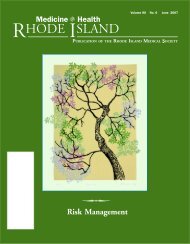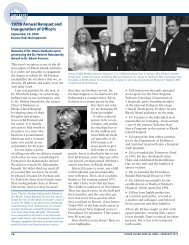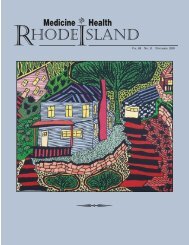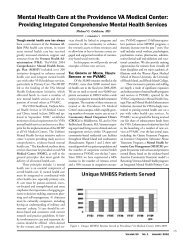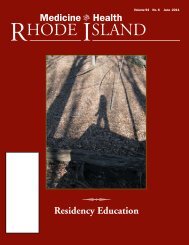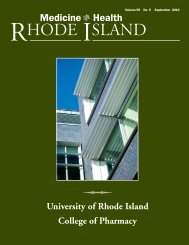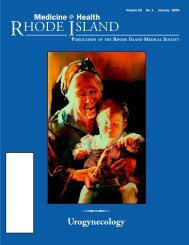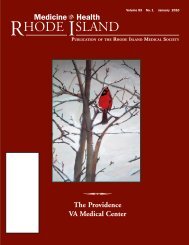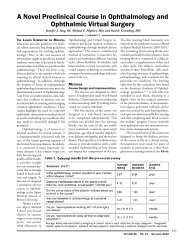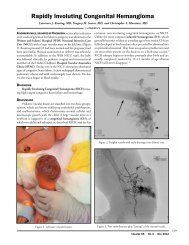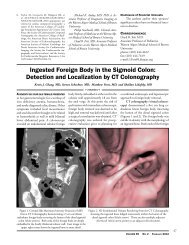Hyperuricemia & Gout - Rhode Island Medical Society
Hyperuricemia & Gout - Rhode Island Medical Society
Hyperuricemia & Gout - Rhode Island Medical Society
Create successful ePaper yourself
Turn your PDF publications into a flip-book with our unique Google optimized e-Paper software.
5. Strausbaugh LJ. Emerging health care- associated infections in the geriatric<br />
population. Emerging Infectious Dis 2001;7:268-71.<br />
6. Davey P. Management of suspected bacterial urinary tract infection in adults, A<br />
national clinical guidelines, Scottish Intercollegiate Guidelines Network, July 2006<br />
7. Treatment Guidelines from The <strong>Medical</strong> Letter 2007; 5 (57).<br />
8. McGeer A, Campbell B, et al. Definitions of infection for surveillance in longterm<br />
care facilities. Am J Infect Control 1991;19:1-7.<br />
9. Centers for Medicare & Medicaid Services. State Operations Manual. Appendix<br />
PP, Section 483.25(d); 2005. Publication #100-07. http://cms.hhs.gov/<br />
manuals/Downloads/som107ap_pp_guidelines_ltcf.pdf.<br />
10. Loeb M, Bentley DW, et al. Development of minimum criteria for the initiation<br />
of antibiotics in residents of long-term care facilities. Infect Control Hosp<br />
Epidemiol 2001;22:120-4.<br />
11. Juthani-Mehta M. Asymptomatic bacteriuria and urinary tract infection in<br />
older adults. Clinics Geriatric Med 2007; 23:585-94.<br />
12. Juthani-Mehta M. Nursing home practitioner survey of diagnostic criteria for<br />
urinary tract infections. J Amer Geriatrics Soc 2005; 53:1989-90.<br />
13. Warren JW. Guidelines for antimicrobial treatment of uncomplicated acute bacterial<br />
cystitis and acute pyelonephritis in women. Clin Infectious Dis 1999; 29:745-58.<br />
14. Hummers-Pradier E. Management of urinary tract infections in female general<br />
practice patients. Fam Practice 2005; 22:71-7.<br />
15. Nicolle LE. Resistant pathogens in urinary tract infections. J Amer Geriatrics<br />
Soc .2002;50S230-5.<br />
16. Fihn SD. Acute uncomplicated urinary tract infection. NEJM 2003;349:259-66.<br />
Porpon Rotjanapan, MD, is an Infectious Disease Fellow at<br />
the University of Iowa Hospitals and Clinics.<br />
David Dosa, MD, is Assistant Professor of Medicine and<br />
Community Health, The Warren Alpert School of Medicine.<br />
Disclosure of Financial Interests<br />
The authors have no financial interests to disclose.<br />
9SOW-RI-GERIATRICS-112009<br />
THE ANALYSES UPON WHICH THIS PUBLICATION IS BASED were performed<br />
under Contract Number 500-02-RI02, funded by the<br />
Centers for Medicare & Medicaid Services, an agency of the<br />
U.S. Department of Health and Human Services. The content<br />
of this publication does not necessarily reflect the views or policies<br />
of the Department of Health and Human Services, nor does<br />
mention of trade names, commercial products, or organizations<br />
imply endorsement by the U.S. Government. The author assumes<br />
full responsibility for the accuracy and completeness of<br />
the ideas presented.<br />
The vagus nerve, sometimes called the<br />
pneumogastric nerve, is the tenth of<br />
twelve paired nerves emanating from the<br />
primate brain stem and are collectively<br />
called the cranial nerves. It is the longest<br />
and most complex of the cranial nerves.<br />
It emerges from the medulla oblongata,<br />
between the olivary nucleus and the inferior<br />
cerebellar peduncle; it then exits<br />
the infratentorial space through the jugular<br />
foramen, courses caudally through the<br />
carotid sheath and finally distributes its<br />
roots to structures in the neck, thorax<br />
and, via the diaphragm, the abdomen.<br />
About 80% of its fibers are sensory but it<br />
does innervate numerous muscles including<br />
those of the larynx and also carries<br />
parasympathetic fibers.<br />
The phrase, vagus nerve, is derived<br />
from the Latin, nervus vagus, meaning<br />
wandering nerve. A number of other<br />
English words are also descended from<br />
the Latin, vagus, all reflecting the sense<br />
of wandering or impermanence. Thus,<br />
one encounters the word, vagabond, (a<br />
Physician’s Lexicon<br />
The Wanderings of the Vagus Nerve<br />
<br />
person leading a wandering, nomadic life<br />
and sometimes thought to be shiftless,<br />
irresponsible and without a permanent<br />
home); the word, vagrant, (a person with<br />
neither home not visible means of support,<br />
a wanderer); the word, vague,<br />
(something not clearly perceived or understood,<br />
something imprecise); and extravagant<br />
(spending too much; wandering<br />
beyond the bounds of fiscal reason<br />
and prudence). And the words reverie<br />
and rave are distantly related.<br />
Still further English words trace back<br />
to the Latin, vagus. A vade mecum (literally,<br />
in Latin, “go with me”) defines working<br />
or instructional manuals in various<br />
occupations and avocations (in more modern<br />
vernacular, “how-to” books). Even the<br />
slang, vamoose (directly from the Spanish,<br />
vamos, meaning let us go; previously<br />
from the Latin, vadere, meaning to go, and<br />
ultimately from the Latin, vagus.)<br />
The word, wander, however, is<br />
purely Germanic (through various north<br />
Teutonic permutations including Old<br />
English) with not a trace of Latin or<br />
Greek. The word, vandal, derives from<br />
it; and through a reverse linguistic migration<br />
then turns up in Latin as<br />
Vandalus, the name that the Romans bestowed<br />
upon the pagan Germanic tribes<br />
that ravaged Spain and Gaul particularly<br />
during the Fifth Century.<br />
The vagus nerve has been a sturdy<br />
mainstay within textbooks on neuroanatomy<br />
for centuries. No medical student<br />
could possibly consider promotion<br />
to the clinical years without knowing the<br />
distribution and sensory/motor responsibilities<br />
of this important cranial nerve.<br />
And now, with the increasing employment<br />
of the vagus nerve stimulator<br />
(VNS) as a therapeutic adjunct, the nerve<br />
has assumed even greater practical importance.<br />
– STANLEY M. ARONSON, MD<br />
VOLUME 92 NO. 11 NOVEMBER 2009<br />
379



